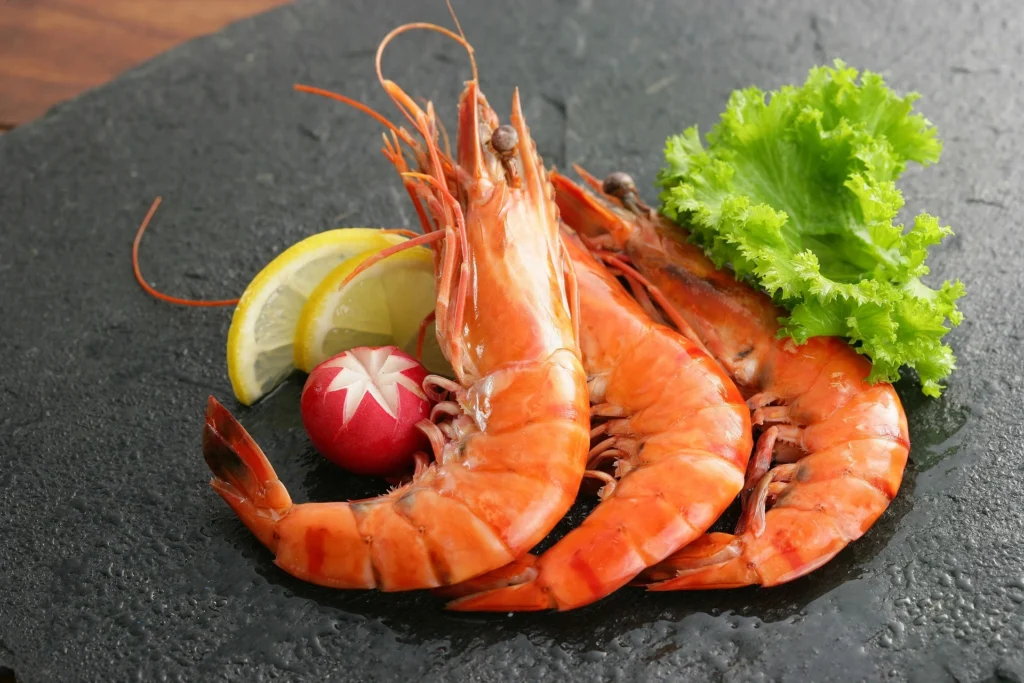Dogs love a good treat, and shrimp might seem like a delicious option to share with your pet. But, many dog owners ask, can dogs have shrimp tails? While shrimp meat can be a safe treat, the tails are another story. In this article, we will dive deep into whether dogs can safely eat shrimp tails, the potential risks involved, and how you can safely feed shrimp to your furry companion.
Table of Contents

Can Dogs Have Shrimp Tails?
The big question here is, can dogs have shrimp tails without facing any health risks? The short answer is no. Shrimp tails are made of a tough, indigestible material called chitin. This makes them difficult for dogs to chew and digest, posing risks such as choking or intestinal blockage. While it may seem harmless to toss your dog a shrimp tail after a seafood dinner, it’s crucial to understand the potential dangers.
What Happens If a Dog Eats Shrimp Tails?
If you’re asking yourself, can dogs have shrimp tails, the answer is clear: they shouldn’t. Shrimp tails, even when cooked, remain hard and brittle. This makes them a choking hazard, particularly for smaller dogs or dogs that tend to gulp their food. Once swallowed, shrimp tails don’t break down easily in a dog’s digestive system, which can lead to blockages in the intestines.
Can dogs have shrimp tails if they are cut into smaller pieces? Unfortunately, no. Even smaller pieces of shrimp tails pose the same risks as larger ones. The sharp edges of the tails can scrape the throat and cause discomfort or worse, internal injuries.
Are There Any Benefits to Feeding Shrimp Meat to Dogs?
While can dogs have shrimp tails is a resounding no, shrimp meat, when properly prepared, can actually be a nutritious treat for your dog. Shrimp is packed with:
- High-quality protein: Shrimp is a great source of protein, which is essential for muscle development and repair in dogs.
- Omega-3 fatty acids: These healthy fats contribute to a shiny coat, healthy skin, and improved brain function.
- Antioxidants: Shrimp contains antioxidants that help fight inflammation and can support overall immune health.
However, it’s essential to avoid feeding your dog shrimp that is seasoned, fried, or cooked with oils, butter, or spices that could upset your dog’s stomach.

Why Can’t Dogs Have Shrimp Tails?
You may still be wondering, can dogs have shrimp tails if they’re raw or cooked differently? The answer remains no, and here’s why:
- Choking Hazard: Shrimp tails are tough and sharp, making them a significant choking risk, especially for small dogs. Even larger dogs may struggle to chew shrimp tails properly, leading to the risk of them getting stuck in the throat.
- Digestive Issues: Even if a dog manages to swallow a shrimp tail, it’s not easily digestible. The material that shrimp tails are made of, chitin, doesn’t break down easily in a dog’s digestive tract. This can cause serious problems, such as intestinal blockages, which may require surgical intervention.
- Sharp Edges: The sharp edges of shrimp tails can cause internal injuries. They can scratch the esophagus or intestines, leading to bleeding, pain, and in severe cases, infections.
Can Dogs Have Shrimp Tails If They Are Cooked?
Some dog owners believe that cooking shrimp tails might soften them enough to make them safe for dogs. However, can dogs have shrimp tails cooked? The answer is still no. Cooking doesn’t break down the tough material of the tail. In fact, cooking shrimp tails might make them even more brittle and prone to splintering, increasing the risk of injury.
How to Safely Feed Shrimp to Your Dog
Although the answer to can dogs have shrimp tails is negative, shrimp meat can still be a tasty and safe treat for dogs when prepared correctly. Here’s how to safely serve shrimp to your dog:
- Remove the Tail and Shell: Before feeding shrimp to your dog, make sure to completely remove the shell and tail. These parts are not digestible and pose serious health risks.
- Cook the Shrimp Plainly: Avoid using oils, butter, salt, or spices when cooking shrimp for your dog. Boiling or steaming the shrimp is the safest option, as it keeps the shrimp plain and free from potentially harmful ingredients.
- Portion Control: Shrimp should be considered an occasional treat rather than a regular part of your dog’s diet. Stick to small portions, especially if your dog is trying shrimp for the first time. This will help you monitor for any allergic reactions or digestive issues.

Risks of Feeding Shrimp to Dogs
While shrimp meat itself can be nutritious, there are still some risks to consider beyond the shrimp tails. Just because you’re avoiding the tails doesn’t mean shrimp is always 100% safe for your dog. Here are some additional risks:
- Allergies: Like humans, some dogs are allergic to seafood. If your dog has never eaten shrimp before, it’s a good idea to start with a small amount and watch for any signs of an allergic reaction, such as itching, swelling, or gastrointestinal issues.
- High Cholesterol: Shrimp contains high levels of cholesterol. If your dog is prone to high cholesterol or has a pre-existing heart condition, it’s best to avoid shrimp altogether.
What to Do If Your Dog Accidentally Eats Shrimp Tails
If you accidentally dropped a shrimp tail and your dog gobbled it up before you could stop them, you may be worried about what happens next. Can dogs have shrimp tails without immediate consequences? Unfortunately, this can still be a concern. Here’s what to do:
- Watch for Signs of Choking: If your dog starts coughing, gagging, or showing difficulty breathing, they may have a shrimp tail lodged in their throat. In this case, you should take your dog to the vet immediately.
- Monitor for Digestive Issues: Even if your dog seems fine initially, keep a close eye on them for the next 24 to 48 hours. If they show signs of vomiting, constipation, or lethargy, this could indicate a blockage in the intestines, which is a medical emergency.

Cooked Shrimp Tails vs. Raw Shrimp Tails: Which is Worse?
Some pet owners wonder whether can dogs have shrimp tails if they are raw versus cooked. Both raw and cooked shrimp tails are problematic for dogs. Raw shrimp tails can contain bacteria that may cause food poisoning, while cooked tails can splinter more easily, increasing the chances of internal damage. Regardless of how the shrimp is prepared, the tails should always be removed before offering shrimp to your dog.
Alternatives to Shrimp Tails for Dogs
Instead of risking your dog’s health by giving them shrimp tails, consider safer alternatives. Some great options include:
- Cooked, peeled shrimp: Just the meat without the tail or shell is a great option for dogs in small amounts.
- Fish like salmon or whitefish: These are rich in omega-3 fatty acids and are safe for dogs when properly cooked and served without seasoning.
- Lean meats: If you’re looking for protein options outside of seafood, lean meats like chicken or turkey are excellent alternatives to shrimp.
How Often Can Dogs Have Shrimp (Without the Tails)?
While can dogs have shrimp tails is not advised, shrimp meat can be fed occasionally. Shrimp should not be a daily part of your dog’s diet. The high cholesterol content in shrimp makes it important to limit how often you serve it. Treat shrimp as an occasional snack, maybe once a week, in small portions.

Consult Your Vet Before Feeding Seafood to Your Dog
Before you introduce shrimp or any new food into your dog’s diet, it’s a good idea to consult your vet. They can help you determine if seafood is suitable for your dog’s specific needs and guide you on safe feeding practices. Your vet may also have some specific recommendations based on your dog’s size, breed, and overall health.
Conclusion
So, can dogs have shrimp tails? The answer is a clear no. Shrimp tails are tough, indigestible, and pose serious risks like choking and intestinal blockage. However, shrimp meat, when prepared properly, can be a healthy and tasty treat for your dog. Remember to remove the tails and shells, cook the shrimp plainly, and serve it in moderation. Always consult your vet if you’re unsure whether seafood is a good addition to your dog’s diet. By following these simple precautions, you can safely share the occasional shrimp treat with your furry friend without worrying about the risks associated with shrimp tails.
FAQs
- Can dogs eat other seafood besides shrimp?
Yes, dogs can eat certain types of seafood like salmon or whitefish, as long as it’s cooked and served without seasoning. - How do I know if my dog is allergic to shrimp?
Signs of shrimp allergies in dogs include itching, swelling, vomiting, and diarrhea. Start with small portions and monitor your dog for any unusual reactions. - Are shrimp shells as dangerous as shrimp tails?
Yes, shrimp shells pose similar risks to shrimp tails. Both are tough and indigestible, making them a choking hazard and potentially causing intestinal blockages. - What seafood is toxic to dogs?
Fish with high mercury content, such as tuna, should be avoided. Also, raw shellfish can contain harmful bacteria that can make your dog sick. - Can dogs have cooked shrimp without the tails?
Yes, cooked shrimp without the tails and shells can be a safe treat for dogs when served in moderation. Make sure the shrimp is plain and free of seasoning or oils.





